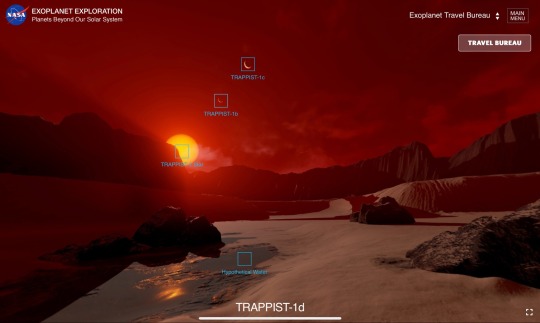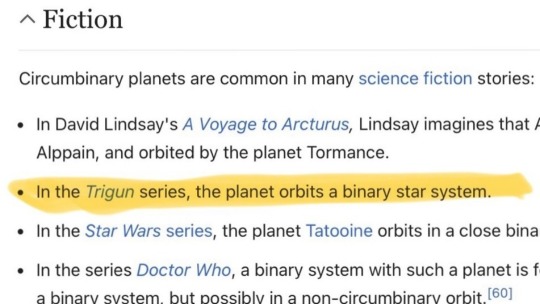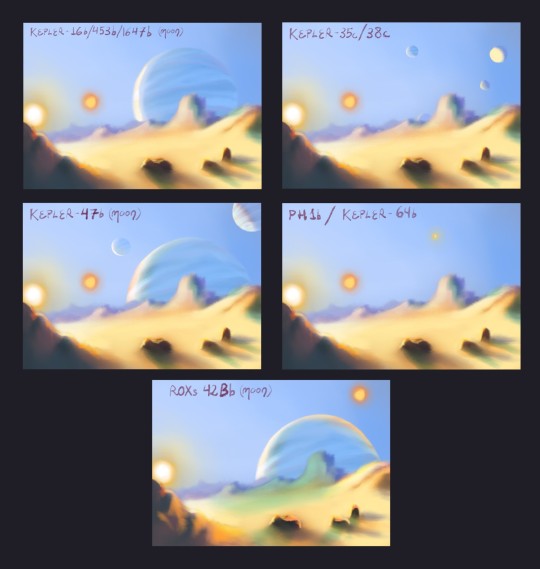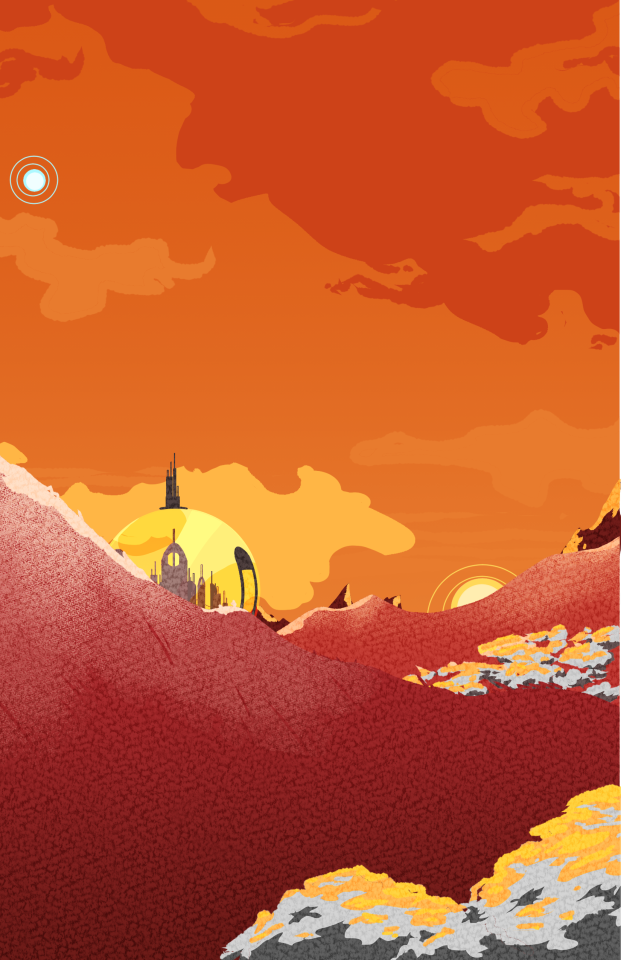#Binary star systems
Explore tagged Tumblr posts
Text
The celestial object of the day is Spica!


The brightest star in the constellation of Virgo is actually a binary system! And the closest to the sun. It's formed by a blue giant and a variable star, they orbit so close together that they've gained an ellipsodal shape, similar to that of an egg
#First image credit: Marion Haligowski#Second image credit: by Fred Espenak#Aaand fun fact: thay orbit so close together that they are indistinguishable by telescope#so we need to use their spectra instead!#First original post of the blog (since all the others are Twitter reposts)#And first star too!!#Now only missing a black hole a neutron star and a galaxy cluster!!#astronomy#astrophotography#outer space#space#nasa#nasa photos#science#space exploration#space photography#celestial object of the day#Star#Stars#binary system#binary star systems#Virgo#Spica
47 notes
·
View notes
Text
My fellow Trigun enjoyers, assemble 🙌🏻
If you had to guess, which planet/moon do you think would most likely be Noman’s Land/Gunsmoke?
I’ve been thinking about this for a while (because my latest obsession is astronomy, although it’s also a long running one). In both animes and manga there are two suns, but I’ve been generally looking at exoplanets (planets outside our Solar System) within the habitable zone of their stars, thinking it would be complicated to find a two-star (binary) system that could have any kind of habitability. Yesterday though I found THIS OFFICIAL ART FROM NASA:

(Look at this, it’s so pretty!)
Turns out, NASA has a whole site that is… kind of an AU in which space travel is viable, and they explain how these planets would look like and what events would be cool to see in them and whatnot. They even have some 3D rendering from the surface of those planets so that you can see how it would look like! When I say this website is cool, I’m underselling it:

ANYWAY, back to Trigun shenanigans! When I saw the poster for Kepler-16b, I realized that yes, you could actually live on a planet of a binary system! These are called circumbinary planets, and a funny detail when you read the Wikipedia page:

A quick note on nomenclature: from what I’ve gathered, the name of the star system is followed by a letter or two. If it’s in caps, it’s a star, with A being the primary one and B the secondary; if it’s in lower case, it’s a planet. The planet counter always (?) starts at b, so if there are seven planets in the system called TRAPPIST-1 they would be TRAPPIST-1b, TRAPPIST-1c, TRAPPIST-1d…
Another important note is that there are two types of planetary configuration: If the planet only orbits one star, it’s called S-Type (or non-circumbinary planet); if it orbits both stars, it’s called P-Type (or circumbinary). Hope this didn’t get too confusing!
So I’ve made a list of binary systems that could potentially host human life. Which one do you think would be the best choice?
Kepler-16: the NASA poster one, its planet unofficially called “Tatooine” amongst scientists (good for them). 16b (the planet) is, however, a gas giant like Saturn, so it would be impossible to live there. If it has a moon with an atmosphere though, that could host life! And we’d get to see in the sky two stars and one bigass planet covering a good chunk of it. Pretty neat 🪐
Kepler-35: The planet discovered here is not within the habitable zone, but there is a high chance there might be other rocky planets in it. We can just make it up however we want it to be ✨
Kepler-38: Same as 35, but also the mass of the planet is unknown (I think? Wikipedia says one thing and NASA another, so idk)
Kepler-47: It has 3 planets, which is very cool 🪐🪐🪐 The second one, 47c, is within the habitable zone, but it would be the same case as 16b (living on a moon). The other two planets would also be perfectly visible, I think.
PH1/Kepler-64: First circumbinary planet found in a quadruple (FOUR STARTS ⭐️⭐️⭐️⭐️) system, and the discovery was made by citizens! How cool is that!? The planet orbits two of them, but the other system is fairly near and probably influences the planet?. They’re probably perfectly visible from the surface.
ROXs 42: Not much known about the planet, but it orbits the secondary star and has an atmosphere💫 That’s because it’s a gas giant, so it’s not habitable and we’d have to use a moon. Would be cool to see the stars wandering the sky on different paths though, since it’s the only S-Type system in this list!
Kepler-453: I’ve gotten confusing info about the habitability zone on this system, but we know that there’s a gas giant half the size of Jupiter 🤔
Kepler-1647: Same as Kepler-16 and 47. Apparently the system would be capable of sustaining an Earth-sized moon! 🌑
A quick sketch of how each of them would look like:

#Trigun#Astronomy#trigun maximum#trigun stampede#Trigun 98#no man's land#Noman's Land#Gunsmoke#Vash the Stampede#Taking worldbuilding too seriously#Exoplanets#Habitable exoplanets#Binary star systems#NASA#NASA exoplanet travel bureau#science fiction#Sci-Fi#Look its for an AU I'm cooking#Neddea#My art#My stuff#My deep dive into rabbit holes that are way too deep for my brain to comprehend
60 notes
·
View notes
Text

Explosions Discovered Near Galactic Center - February 28th, 1996.
"Tremendous explosions near the center of our galaxy were discovered in December, 1995, and were announced by a paper in Nature and a press conference at NASA. Bursts like these had never been seen before, and so the exact cause was unknown and was said to likely be the source of astronomical speculations and observations for years to come. Much more powerful than any explosions we humans can create, these eruptions likely involve the extreme conditions found only on the surface of a neutron star in a binary system, possibly similar to the X-ray binary system depicted in the above drawing. The new source, dubbed GRO J1744-28 for its discovery spacecraft and position, produces multiple pulsed bursts of energy per day, each of which last several seconds. The bursts are quite prominent in X-ray light. Discovery team leaders included Chryssa Kouveliotou (USRA) and Gerald Fishman (NASA /MSFC)."
52 notes
·
View notes
Text
The Corona Borealis is home to a white dwarf star named T Coronae Borealis. It is in a binary star system with a red giant type star.
As the red giant in T CrB's system ejects matter, T CrB's gravity attracts or collects it and puts it on its own surface, doing so for years and years, until it reaches its limit.
REFERENCE LINKS IN THE ARTICLE
4 notes
·
View notes
Text
wowa new ocs
Based them off binary star systems which are kinda unappreciated but yeah start sister gals

4 notes
·
View notes
Text
[Image description: a screenshot of the notes. tenkitkatdreams tags #star yuri
routeriver tags #this too is yuri.]
wait till the tumblr girlies find out that in binary star systems sometimes one star will basically eat the other and kill them both - resulting in the most powerful thing a star could ever do in its life.
60K notes
·
View notes
Text
#star explosion#recurrent novas#binary star systems#Corona Borealis#astronomy#the universe does not necessarily speak your language
0 notes
Text

Stars Binary System - by Breath Art
#celestial enrichment#celestial ceiling#binary star systems#stellar audience#stellar enrichment#stellar odyssey#under starry skies#under the milky way#celestial odyssey#stellar
0 notes
Text
"Lagrange Points in Binary Star Systems"
By Daniel Gallego and Layla Xholi
1 note
·
View note
Text

Dust clouds in Aries, the Ram // darkdesertdome
The bright star to the left is 47 Arietis and the bright star to the right is ε Arietis.
#astronomy#astrophotography#nebula#dark nebula#dust#interstellar dust#star#single star#star system#binary star#binary star system#47 Arietis#epsilon arietis#aries
194 notes
·
View notes
Text

I don't know about you guys, but having to relive the moment I killed one of the biggest loves of my life on live TV is actually my idea of an ideal night.
This is once again a collab comic for the Binary Star System fic series! This time based on chapter two of Apollo's Very Scary Halloween! I am v late with posting this :') but I hope y'all enjoy and check out the fic! Credits for the all the fics in this series go to @cows-and-crows!
#trials of apollo#toa apollo#lester papadopoulos#OC#fanfic#binary star system#apollart#This fic will also feed all the whumptober fans#Bc we couldn't let Apollo and his kids be happy for too long :)#also I had to nerf the quality of this comic a lil bit because it was actually too big of a file for tumblr lmao
195 notes
·
View notes
Text

I made an Unbreakable Bond AU 😄🌌✨️
Binary-Star System Sonic & Tails
Sonic is based on a Blue Main Sequence Star
Tails is based on a Red Giant
When they're in this form they can't be separated, and they have ultimate destructive power!
Probably my personal favorite AU I've made yet 🌌 I'm still working on a story for it, but for right now I have their designs ✨️
#sonic the hedgehog#tails the fox#binary star system sonic and tails#unbreakable bond#sonic and tails#sonic au#classic sonic#im so excited to share this one ahhhhh#wholesome sonic and tails wednesday#wsatw#blue star sonic#red giant tails
164 notes
·
View notes
Text

I'd say nothing can escape my Whims bu the truth is I was useless for the better part of 3 days until I tried my hand at the Shining World of the Seven Systems
#Gallifrey#doctor who#scifi#illustration#digital#love me a binary star system i do#fanart#i believe it was rewatching the 50th anni special m being upsetti gallifrey was so hard to see through all the#yknow#war happening#needed me some snow-capped red grass and silver trees
125 notes
·
View notes
Text
The system is made of two stars, a large red giant whose outer layers are loosely bound to it and a tiny and dense white dwarf, the degenerate core of a former red giant. The two objects are in a parasitic relationship.
The white dwarf steals material from the red giant. This process might one day push the white dwarf beyond a certain mass limit and turn it into a supernova, which would destroy the star
This explosion happened once every 15 years and makes the white dwarf shine brighter
0 notes
Text
Octavian living would’ve been infinitely more interesting than killing him off.
Give me Octavian who is now forced to reside in the Apollo cabin, forced to get know the Greeks. Give me Octavian having to slowly win their approval. Give me Octavian messing up and ending up back at square one.
And give me Octavian having to deal with Lester. The guilt, of knowing that someone you looked up to is now being punished because of something you did.
#trials of apollo#toa#apollo#pjo apollo#toa apollo#Octavian#a lot of this is just from the binary Star system Octavian lives AU#bc I truly think if Fen was there he would’ve talked to him#but also just in general it’d be interesting
117 notes
·
View notes
Text

Drew Binary Star System Sonic from @star-stages's Unbreakable Bond Au ✨💙 He's a Blue Main Sequence Star! 😄
#gift art#not my au#sonic au#binary star system sonic#blue star sonic#sonic the hedgehog#sonic#sth#sonic fanart#sonic art#unbreakable bond au
72 notes
·
View notes